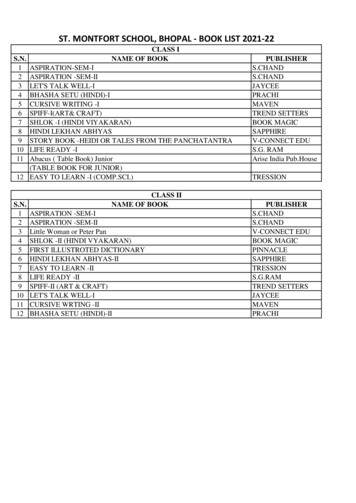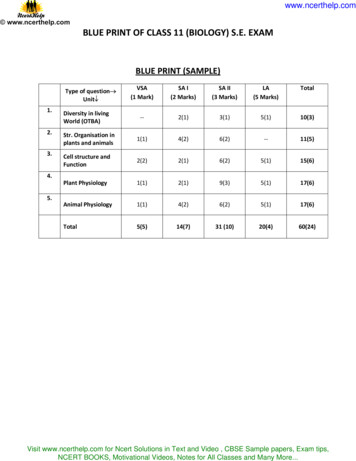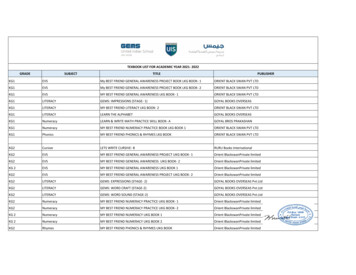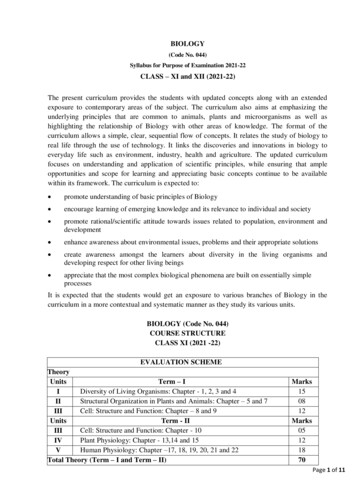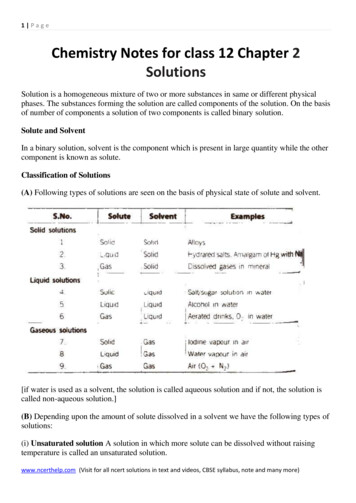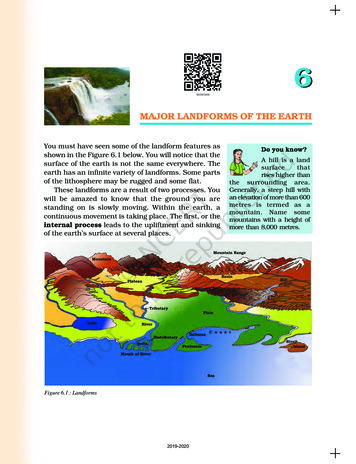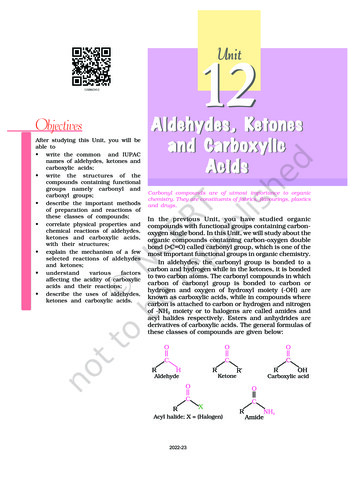
Transcription
Unit12ObjectivesAfter studying this Unit, you will beable to write the common and IUPACnames of aldehydes, ketones andcarboxylic acids; write the structures of thecompounds containing functionalgroups namely carbonyl andcarboxyl groups; describe the important methodsof preparation and reactions ofthese classes of compounds; correlate physical properties andchemical reactions of aldehydes,ketones and carboxylic acids,with their structures; explain the mechanism of a fewselected reactions of aldehydesand ketones; understandvariousfactorsaffecting the acidity of carboxylicacids and their reactions; describe the uses of aldehydes,ketones and carboxylic acids.AldehydesAldehydes,, Ke tonesand CarboxylicA cidsCarbonyl compounds are of utmost importance to organicchemistry. They are constituents of fabrics, flavourings, plasticsand drugs.In the previous Unit, you have studied organiccompounds with functional groups containing carbonoxygen single bond. In this Unit, we will study about theorganic compounds containing carbon-oxygen doublebond ( C O) called carbonyl group, which is one of themost important functional groups in organic chemistry.In aldehydes, the carbonyl group is bonded to acarbon and hydrogen while in the ketones, it is bondedto two carbon atoms. The carbonyl compounds in whichcarbon of carbonyl group is bonded to carbon orhydrogen and oxygen of hydroxyl moiety (-OH) areknown as carboxylic acids, while in compounds wherecarbon is attached to carbon or hydrogen and nitrogenof -NH2 moiety or to halogens are called amides andacyl halides respectively. Esters and anhydrides arederivatives of carboxylic acids. The general formulas ofthese classes of compounds are given below:2022-23
Aldehydes, ketones and carboxylic acids are widespread in plantsand animal kingdom. They play an important role in biochemicalprocesses of life. They add fragrance and flavour to nature, for example,vanillin (from vanilla beans), salicylaldehyde (from meadow sweet) andcinnamaldehyde (from cinnamon) have very pleasant fragrances.They are used in many food products and pharmaceuticals to addflavours. Some of these families are manufactured for use as solvents(i.e., acetone) and for preparing materials like adhesives, paints, resins,perfumes, plastics, fabrics, etc.12.1 Nomenclature and Structure of Carbonyl Group12.1.1NomenclatureI.Aldehydes and ketonesAldehydes and ketones are the simplest and most important carbonylcompounds.There are two systems of nomenclature of aldehydes and ketones.(a) Common namesAldehydes and ketones are often called by their common namesinstead of IUPAC names. The common names of most aldehydes arederived from the common names of the corresponding carboxylicacids [Section 12.6.1] by replacing the ending –ic of acid with aldehyde.At the same time, the names reflect the Latin or Greek term for theoriginal source of the acid or aldehyde. The location of the substituentin the carbon chain is indicated by Greek letters α, β, γ, δ, etc. Theα-carbon being the one directly linked to the aldehyde group, βcarbon the next, and so on. For exampleChemistry 3582022-23
The common names of ketones are derived by naming two alkylor aryl groups bonded to the carbonyl group. The locations ofsubstituents are indicated by Greek letters, α α′, β β′ and so onbeginning with the carbon atoms next to the carbonyl group,indicated as αα′. Some ketones have historical common names,the simplest dimethyl ketone is called acetone. Alkyl phenylketones are usually named by adding the name of acyl group asprefix to the word phenone. For example(b) IUPAC namesThe IUPAC names of open chain aliphatic aldehydes and ketonesare derived from the names of the corresponding alkanes byreplacing the ending –e with –al and –one respectively. In case ofaldehydes the longest carbon chain is numbered starting from thecarbon of the aldehyde group while in case of ketones thenumbering begins from the end nearer to the carbonyl group. Thesubstituents are prefixed in alphabetical order along with numeralsindicating their positions in the carbon chain. The same applies tocyclic ketones, where the carbonyl carbon is numbered one. Whenthe aldehyde group is attached to a ring, the suffix carbaldehydeis added after the full name of the cycloalkane. The numbering ofthe ring carbon atoms start from the carbon atom attached to thealdehyde group. The name of the simplest aromatic aldehydecarrying the aldehyde group on a benzene ring isbenzenecarbaldehyde. However, the common name benzaldehydeis also accepted by IUPAC. Other aromatic aldehydes are hencenamed as substituted benzaldehydes.3592022-23Aldehydes, Ketones and Carboxylic Acids
The common and IUPAC names of some aldehydes and ketones aregiven in Table 12.1.Table 12.1: Common and IUPAC Names of Some Aldehydes and KetonesStructureCommon nameIUPAC dePentanalCH2 ethyl n-propyl ketonePentan-2-one(CH3)2CHCOCH(CH3)2Diisopropyl ne2-MethylcyclohexanoneMesityl oxide4-Methylpent-3-en-2-one(CH3)2C CHCOCH3Chemistry 3602022-23
12.1.2 Structureof theCarbonylGroup2The carbonyl carbon atom is sp -hybridised and forms three sigma (σ)bonds. The fourth valence electron of carbon remains in its p-orbitaland forms a π-bond with oxygen by overlap with p-orbital of an oxygen.In addition, the oxygen atom also has two non bonding electron pairs.Thus, the carbonyl carbon and the three atoms attached to it lie in thesame plane and the π-electron cloud is above and below this plane. Thebond angles are approximately 120 as expected of a trigonal coplanarstructure (Figure 12.1).πFig.12.1 Orbital diagram for the formation of carbonyl groupThe carbon-oxygen double bond is polarised due to higherelectronegativity of oxygen relative to carbon. Hence, the carbonylcarbon is an electrophilic (Lewis acid), and carbonyloxygen, a nucleophilic (Lewis base) centre. Carbonylcompounds have substantial dipole moments and arepolar than ethers. The high polarity of the carbonyl groupis explained on the basis of resonance involving a neutral(A) and a dipolar (B) structures as shown.Intext Questions12.1 Write the structures of the following compounds.(i) α-Methoxypropionaldehyde(ii) 3-Hydroxybutanal(iii) 2-Hydroxycyclopentane carbaldehyde(iv) 4-Oxopentanal(v) Di-sec. butyl ketone(vi) 4-Fluoroacetophenone12.2 Preparation of Aldehydesand Ketones12.2.1 PreparationofAldehydesandKetonesSome important methods for the preparation of aldehydesand ketones are as follows:1. By oxidation of alcoholsAldehydes and ketones are generally prepared by oxidation of primaryand secondary alcohols, respectively (Unit 11, Class XII).2. By dehydrogenation of alcoholsThis method is suitable for volatile alcohols and is of industrialapplication. In this method alcohol vapours are passed over heavymetal catalysts (Ag or Cu). Primary and secondary alcohols givealdehydes and ketones, respectively (Unit 11, Class XII).3. From hydrocarbons(i) By ozonolysis of alkenes: As we know, ozonolysis of alkenesfollowed by reaction with zinc dust and water gives aldehydes,3612022-23Aldehydes, Ketones and Carboxylic Acids
ketones or a mixture of both depending on the substitutionpattern of the alkene (Unit 13, Class XI).(ii) By hydration of alkynes: Addition of water to ethyne in thepresence of H2SO4 and HgSO4 gives acetaldehyde. All otheralkynes give ketones in this reaction (Unit 13, Class XI).12.2.2 PreparationofAldehydes1. From acyl chloride (acid chloride)Acyl chloride (acid chloride) is hydrogenated over catalyst, palladiumon barium sulphate. This reaction is called Rosenmund reduction.2. From nitriles and estersNitriles are reduced to corresponding imine with stannous chloridein the presence of hydrochloric acid, which on hydrolysis givecorresponding aldehyde.This reaction is called Stephen edbydiisobutylaluminium hydride, (DIBAL-H) to imines followed byhydrolysis to aldehydes:Similarly, esters are also reduced to aldehydes with DIBAL-H.3. From hydrocarbonsAromatic aldehydes (benzaldehyde and its derivatives) are preparedfrom aromatic hydrocarbons by the following methods:(i) By oxidation of methylbenzeneStrong oxidising agents oxidise toluene and its derivatives tobenzoic acids. However, it is possible to stop the oxidation atthe aldehyde stage with suitable reagents that convert the methylgroup to an intermediate that is difficult to oxidise further. Thefollowing methods are used for this purpose.(a) Use of chromyl chloride (CrO2Cl2): Chromyl chloride oxidisesmethyl group to a chromium complex, which on hydrolysisgives corresponding benzaldehyde.Chemistry 3622022-23
This reaction is called Etard reaction.(b) Use of chromic oxide (CrO3): Toluene or substituted tolueneis converted to benzylidene diacetate on treating with chromicoxide in acetic anhydride. The benzylidene diacetate can behydrolysed to corresponding benzaldehyde with aqueous acid.(ii) By side chain chlorination followed by hydrolysisSide chain chlorination of toluene gives benzal chloride, whichon hydrolysis gives benzaldehyde. This is a commercial methodof manufacture of benzaldehyde.(iii) By Gatterman – Koch reactionWhen benzene or its derivative is treated with carbon monoxideand hydrogen chloride in the presence of anhydrous aluminiumchloride or cuprous chloride, it gives benzaldehyde or substitutedbenzaldehyde.This reaction is known as Gatterman-Koch reaction.12.2.3 Preparationof Ketones1. From acyl chloridesTreatment of acyl chlorides with dialkylcadmium, prepared by thereaction of cadmium chloride with Grignard reagent, gives ketones.3632022-23Aldehydes, Ketones and Carboxylic Acids
2. From nitrilesTreating a nitrile with Grignard reagent followed by hydrolysis yieldsa ketone.3. From benzene or substituted benzenesWhen benzene or substituted benzene is treated with acid chloride inthe presence of anhydrous aluminium chloride, it affords thecorresponding ketone. This reaction is known as Friedel-Craftsacylation reaction.Example 12.1SolutionGive names of the reagents to bring about the followingtransformations:(i) Hexan-1-ol to hexanal(ii) Cyclohexanol to cyclohexanone(iii) p-Fluorotoluene to(iv) Ethanenitrile to ethanalp-fluorobenzaldehyde(v) Allyl alcohol to propenal(vi) But-2-ene to ethanal(i) C5H5NH CrO3Cl-(PCC)(iii) CrO3 in the presenceof acetic anhydride/1. CrO2Cl2 2. HOH(v) PCC(ii) Anhydrous CrO3(iv) (Diisobutyl)aluminiumhydride (DIBAL-H)(vi) O3/H2O-Zn dustIntext Question12.2 Write the structures of products of the following reactions;(i)(ii)(C6H5CH2)2 Cd 2 CH3 COClCH3(iii)H3C C C HHg2 , H2SO41.CrO2Cl2(iv)2.H3 O NO2Chemistry 3642022-23
12.3 PhysicalPropertiesThe physical properties of aldehydes and ketones are described asfollows.Methanal is a gas at room temperature. Ethanal is a volatile liquid.Other aldehydes and ketones are liquid or solid at room temperature.The boiling points of aldehydes and ketones are higher thanhydrocarbons and ethers of comparable molecular masses. It is due toweak molecular association in aldehydes and ketones arising out of thedipole-dipole interactions. Also, their boiling points are lower than thoseof alcohols of similar molecular masses due to absence of intermolecularhydrogen bonding. The following compounds of molecular masses 58and 60 are ranked in order of increasing boiling 1-olb.p.(K)Molecular Mass2732813223293705860585860The lower members of aldehydes and ketones such as methanal,ethanal and propanone are miscible with water in all proportions,because they form hydrogen bond with water.However, the solubility of aldehydes and ketones decreases rapidlyon increasing the length of alkyl chain. All aldehydes and ketones arefairly soluble in organic solvents like benzene, ether, methanol,chloroform, etc. The lower aldehydes have sharp pungent odours. Asthe size of the molecule increases, the odour becomes less pungentand more fragrant. In fact, many naturally occurring aldehydes andketones are used in the blending of perfumes and flavouring agents.Arrange the following compounds in the increasing order of theirboiling points:CH3CH2CH2CHO, CH3CH2CH2CH2OH, H5C2-O-C2H5, CH3CH2CH2CH3Example 12.2The molecular masses of these compounds are in the range of 72 to74. Since only butan-1-ol molecules are associated due to extensiveintermolecular hydrogen bonding, therefore, the boiling point ofbutan-1-ol would be the highest. Butanal is more polar thanethoxyethane. Therefore, the intermolecular dipole-dipole attractionis stronger in the former. n-Pentane molecules have only weak vander Waals forces. Hence increasing order of boiling points of thegiven compounds is as follows:SolutionCH3CH2CH2CH3 H5C2-O-C2H5 CH3CH2CH2CHO CH3CH2CH2CH2OH3652022-23Aldehydes, Ketones and Carboxylic Acids
Intext Question12.3 Arrange the following compounds in increasing order oftheir boiling points.CH3CHO, CH3CH2OH, CH3OCH3, CH3CH2CH312.4 ChemicalReactionsSince aldehydes and ketones both possess the carbonyl functionalgroup, they undergo similar chemical reactions.1. Nucleophilic addition reactionsContrary to electrophilic addition reactions observed in alkenes (referUnit 13, Class XI), the aldehydes and ketones undergo nucleophilicaddition reactions.(i) Mechanism of nucleophilic addition reactionsA nucleophile attacks the electrophilic carbon atom of the polarcarbonyl group from a direction approximately perpendicular to2the plane of sp hybridised orbitals of carbonyl carbon (Fig. 12.2).23The hybridisation of carbon changes from sp to sp in this process,and a tetrahedral alkoxide intermediate is produced. Thisintermediate captures aproton from the reactionmedium to give theelectrically neutral product.The net result is addition of– Nu and H across thecarbon oxygen double bondas shown in Fig. 12.2.Fig.12.2: Nucleophilic attack on carbonyl carbon(ii) ReactivityAldehydes are generally more reactive than ketones innucleophilic addition reactions due to steric and electronicreasons. Sterically, the presence of two relatively largesubstituents in ketones hinders the approach of nucleophile tocarbonyl carbon than in aldehydes having only one suchsubstituent. Electronically, aldehydes are more reactive thanketones because two alkyl groups reduce the electrophilicity ofthe carbonyl carbon more effectively than in former.Example 12.3 Would you expect benzaldehyde to be more reactive or less reactive innucleophilic addition reactions than propanal? Explain your answer.Solution The carbon atom of the carbonyl group of benzaldehyde is lesselectrophilic than carbon atom of the carbonyl group present inpropanal. The polarity of the carbonylgroup is reduced in benzaldehyde dueto resonance as shown below andhence it is less reactive than propanal.Chemistry 3662022-23
(iii) Some important examples of nucleophilic addition andnucleophilic addition-elimination reactions:(a) Addition of hydrogen cyanide (HCN): Aldehydesand ketones react with hydrogen cyanide (HCN)to yield cyanohydrins. This reaction occurs veryslowly with pure HCN. Therefore, it is catalysedby a base and the generated cyanide ion (CN )being a stronger nucleophile readily adds tocarbonyl compounds to yield heticintermediates.(b) Addition of sodium hydrogensulphite: Sodiumhydrogensulphite adds to aldehydes andketones to form the addition products.The position ofthe equilibriumlies largely tothe right handside for mostaldehydes and tothe left for mostketones due to steric reasons. The hydrogensulphite additioncompound is water soluble and can be converted back to theoriginal carbonyl compound by treating it with dilute mineralacid or alkali. Therefore, these are useful for separation andpurification of aldehydes.(c) Addition of Grignard reagents: (refer Unit 11, Class XII).(d) Addition of alcohols: Aldehydes react with one equivalent ofmonohydric alcohol in the presence of dry hydrogen chlorideto yield alkoxyalcohol intermediate, known as hemiacetals,which further react with one more molecule of alcohol togive a gem-dialkoxycompound known asacetal as shown in thereaction.Ketones react withethylene glycol undersimilar conditions to formcyclic products known asethylene glycol ketals.Dry hydrogen chlorideprotonates the oxygen ofthe carbonyl compoundsand therefore, increasesthe electrophilicity of thecarbonyl carbon facilitating3672022-23Aldehydes, Ketones and Carboxylic Acids
the nucleophilic attack of ethylene glycol. Acetals and ketalsare hydrolysed with aqueous mineral acids to yieldcorresponding aldehydes and ketones respectively.(e) Addition of ammonia and its derivatives: Nucleophiles, suchas ammonia and its derivatives H2N-Z add to the carbonylgroup of aldehydes and ketones. The reaction is reversibleand catalysed by acid.Theequilibriumfavours the productformation due to rapiddehydration of theintermediate to form C N-Z.Z Alkyl, aryl, OH, NH2, C6H5NH, NHCONH2, etc.Table 12.2: Some N-Substituted Derivatives of Aldehydes and Ketones ( C N-Z)ZReagent nameCarbonyl derivativeProduct name-HAmmoniaImine-RAmineSubstituted imine(Schiff’s ydrazine2,4 DinitrophenylhydrazoneSemicarbazideSemicarbazone* 2,4-DNP-derivatives are yellow, orange or red solids, useful for characterisation of aldehydes and ketones.2. Reduction(i) Reduction to alcohols: Aldehydes and ketones are reduced toprimary and secondary alcohols respectively by sodiumborohydride (NaBH4) or lithium aluminium hydride (LiAlH4) aswell as by catalytic hydrogenation (Unit 11, Class XII).(ii) Reduction to hydrocarbons: The carbonyl group of aldehydesand ketones is reduced to CH2 group on treatment with zincamalgam and concentrated hydrochloric acid [ClemmensenChemistry 3682022-23
reduction] or with hydrazine followed by heating with sodiumor potassium hydroxide in high boiling solvent such as ethyleneglycol (Wolff-Kishner reduction).3. OxidationBernhard Tollens(1841-1918) was aProfessor of Chemistryat the University ofGottingen, Germany.Aldehydes differ from ketones in their oxidation reactions. Aldehydesare easily oxidised to carboxylic acids on treatment with commonoxidising agents like nitric acid, potassium permanganate, potassiumdichromate, etc. Even mild oxidising agents, mainly Tollens’ reagentand Fehlings’ reagent also oxidise aldehydes.Ketones are generally oxidised under vigorous conditions, i.e.,strong oxidising agents and at elevated temperatures. Their oxidationinvolves carbon-carbon bond cleavage to afford a mixture of carboxylicacids having lesser number of carbon atoms than the parent ketone.The mild oxidising agents given below are used to distinguishaldehydes from ketones:(i) Tollens’ test: On warming an aldehyde with freshly preparedammoniacal silver nitrate solution (Tollens’ reagent), a brightsilver mirror is produced due to the formation of silver metal.The aldehydes are oxidised to corresponding carboxylate anion.The reaction occurs in alkaline medium.(ii) Fehling’s test: Fehling reagent comprises of two solutions,Fehling solution A and Fehling solution B. Fehling solution A isaqueous copper sulphate and Fehling solution B is alkalinesodium potassium tartarate (Rochelle salt). These two solutionsare mixed in equal amounts before test. On heating an aldehydewith Fehling’s reagent, a reddish brown precipitate is obtained.Aldehydes are oxidised to corresponding carboxylate anion.Aromatic aldehydes do not respond to this test.3692022-23Aldehydes, Ketones and Carboxylic Acids
(iii) Oxidation of methyl ketones by haloform reaction:Aldehydes and ketones having at least one methyl grouplinked to the carbonyl carbon atom (methyl ketones)are oxidised by sodium hypohalite to sodium salts ofcorresponding carboxylicacids having one carbonatom less than that ofcarbonyl compound. Themethylgroupisconverted to haloform.This oxidation does notaffect a carbon-carbondouble bond, if presentin the molecule.Iodoform reaction with sodium hypoiodite is also used for detectionof CH3CO group or CH3CH(OH) group which produces CH3CO groupon oxidation.Example 12.4 An organic compound (A) with molecular formula C8H8O forms anorange-red precipitate with 2,4-DNP reagent and gives yellowprecipitate on heating with iodine in the presence of sodiumhydroxide. It neither reduces Tollens’ or Fehlings’ reagent, nor doesit decolourise bromine water or Baeyer’s reagent. On drastic oxidationwith chromic acid, it gives a carboxylic acid (B) having molecularformula C7H6O2. Identify the compounds (A) and (B) and explain thereactions involved.Solution (A) forms 2,4-DNP derivative. Therefore, it is an aldehyde or a ketone.Since it does not reduce Tollens’ or Fehling reagent, (A) must be a ketone.(A) responds to iodoform test. Therefore, it should be a methyl ketone.The molecular formula of (A) indicates high degree of unsaturation, yetit does not decolourise bromine water or Baeyer’s reagent. This indicatesthe presence of unsaturation due to an aromatic ring.Compound (B), being an oxidation product of a ketone should be acarboxylic acid. The molecular formula of (B) indicates that it shouldbe benzoic acid and compound (A) should, therefore, be amonosubstituted aromatic methyl ketone. The molecular formula of(A) indicates that it should be phenyl methyl ketone (acetophenone).Reactions are as follows:Chemistry 3702022-23
4. Reactions due to a-hydrogenAcidity of α-hydrogens of aldehydes and ketones: The aldehydesand ketones undergo a number of reactions due to the acidic natureof α-hydrogen.The acidity of α-hydrogen atoms of carbonyl compounds is dueto the strong electron withdrawing effect of the carbonyl group andresonance stabilisation of the conjugate base.(i) Aldol condensation: Aldehydes and ketones having at least oneα-hydrogen undergo a reaction in the presence of dilute alkalias catalyst to form β-hydroxy aldehydes (aldol) or β-hydroxyketones (ketol), respectively. This is known as Aldol reaction.The name aldol is derived from the names of the twofunctional groups, aldehyde and alcohol, present in the products.The aldol and ketol readily lose water to give α,β-unsaturatedcarbonyl compounds which are aldol condensation productsand the reaction is called Aldol condensation. Though ketonesgive ketols (compounds containing a keto and alcohol groups),the general name aldol condensation still applies to the reactionsof ketones due to their similarity with aldehydes.3712022-23Aldehydes, Ketones and Carboxylic Acids
(ii) Cross aldol condensation: When aldol condensation is carriedout between two different aldehydes and / or ketones, it is calledcross aldol condensation. If both of them contain α-hydrogenatoms, it gives a mixture of four products. This is illustratedbelow by aldol reaction of a mixture of ethanal and propanal.Ketones can also be used as one component in the cross aldolreactions.5. Other reactions(i) Cannizzaro reaction: Aldehydes which do not have anα-hydrogen atom, undergo self oxidation and reduction(disproportionation) reaction on heating with concentrated alkali.In this reaction, one molecule of the aldehyde is reduced toalcohol while another is oxidised to carboxylic acid salt. Chemistry 3722022-23
(ii) Electrophilic substitution reaction: Aromatic aldehydes and ketonesundergo electrophilic substitution at the ring in which the carbonylgroup acts as a deactivating and meta-directing group.Intext Questions12.4 Arrange the following compounds in increasing order of their reactivity innucleophilic addition reactions.(i) Ethanal, Propanal, Propanone, Butanone.(ii) Benzaldehyde, p-Tolualdehyde, p-Nitrobenzaldehyde, Acetophenone.Hint: Consider steric effect and electronic effect.12.5 Predict the products of the following reactions:(i)(ii)(iii)(iv)12.5 Uses ofAldehydesand KetonesIn chemical industry aldehydes and ketones are used as solvents,starting materials and reagents for the synthesis of other products.Formaldehyde is well known as formalin (40%) solution used to preservebiological specimens and to prepare bakelite (a phenol-formaldehyderesin), urea-formaldehyde glues and other polymeric products.Acetaldehyde is used primarily as a starting material in the manufactureof acetic acid, ethyl acetate, vinyl acetate, polymers and drugs.Benzaldehyde is used in perfumery and in dye industries. Acetone andethyl methyl ketone are common industrial solvents. Many aldehydesand ketones, e.g., butyraldehyde, vanillin, acetophenone, camphor, etc.are well known for their odours and flavours.3732022-23Aldehydes, Ketones and Carboxylic Acids
Carboxylic AcidsCarbon compounds containing a carboxyl functional group, –COOH arecalled carboxylic acids. The carboxyl group, consists of a carbonyl groupattached to a hydroxyl group, hence its name carboxyl. Carboxylic acidsmay be aliphatic (RCOOH) or aromatic (ArCOOH) depending on the group,alkyl or aryl, attached to carboxylic carbon. Large number of carboxylicacids are found in nature. Some higher members of aliphatic carboxylicacids (C12 – C18) known as fatty acids, occur in natural fats as esters ofglycerol. Carboxylic acids serve as starting material for several otherimportant organic compounds such as anhydrides, esters, acid chlorides,amides, etc.12.6 Nomenclature and Structure of Carboxyl Group12.6.1NomenclatureSince carboxylic acids are amongst the earliest organic compounds tobe isolated from nature, a large number of them are known by theircommon names. The common names end with the suffix –ic acid andhave been derived from Latin or Greek names of their natural sources.For example, formic acid (HCOOH) was first obtained from red ants(Latin: formica means ant), acetic acid (CH3COOH) from vinegar (Latin:acetum, means vinegar), butyric acid (CH3CH2CH2COOH) from rancidbutter (Latin: butyrum, means butter).In the IUPAC system, aliphatic carboxylic acids are named byreplacing the ending –e in the name of the corresponding alkane with –oic acid. In numbering the carbon chain, the carboxylic carbon isnumbered one. For naming compounds containing more than onecarboxyl group, the alkyl chain leaving carboxyl groups is numberedand the number of carboxyl groups is indicated by adding themultiplicative prefix, dicarboxylic acid, tricarboxylic acid, etc. to the nameof parent alkyl chain. The position of –COOH groups are indicated by thearabic numeral before the multiplicative prefix. Some of the carboxylicacids along with their common and IUPAC names are listed in Table 12.3.Table 12.3 Names and Structures of Some Carboxylic AcidsStructureCommon nameIUPAC nameHCOOHFormic acidMethanoic acidCH3COOHAcetic acidEthanoic acidCH3CH2COOHPropionic acidPropanoic acidCH3CH2CH2COOHButyric acidButanoic acid(CH3)2CHCOOHIsobutyric acid2-Methylpropanoic acidHOOC-COOHOxalic acidEthanedioic acidHOOC -CH2-COOHMalonic acidPropanedioic acidHOOC -(CH2)2-COOHSuccinic acidButanedioic acidHOOC -(CH2)3-COOHGlutaric acidPentanedioic acidHOOC -(CH2)4-COOHAdipic acidHexanedioic acidHOOC -CH2-CH(COOH)-CH2-COOHTricarballylic acidor carballylic acidPropane-1, 2, 3tricarboxylic acidChemistry 3742022-23
12.6.2 Structureof CarboxylGroupBenzoic acidBenzenecarboxylic acid(Benzoic acid)Phenylacetic acid2-Phenylethanoic acidPhthalic acidBenzene-1, 2-dicarboxylicacidIn carboxylic acids, the bonds to the carboxyl carbon lie in one planeand are separated by about 120 . The carboxylic carbon is lesselectrophilic than carbonyl carbon because of the possible resonancestructure shown below: Intext Question12.6 Give the IUPAC names of the following compounds:(i) Ph CH2CH2COOH(ii) (CH3)2C CHCOOHCH3(iii)COOH12.7 Methods ofPreparationof CarboxylicAcids(iv)Some important methods of preparation of carboxylic acids are as follows.1. From primary alcohols and aldehydesPrimary alcohols are readily oxidised to carboxylic acids with commonoxidising agents such as potassium permanganate (KMnO4) inneutral, acidic or alkaline media or by potassium dichromate (K2Cr2O7)and chromium trioxide (CrO3) in acidic media (Jones reagent).Jones reagent3752022-23Aldehydes, Ketones and Carboxylic Acids
Carboxylic acids are also prepared from aldehydes by the use ofmild oxidising agents (Section 12.4).2. From alkylbenzenesAromatic carboxylic acids can be prepared by vigorous oxidation ofalkyl benzenes with chromic acid or acidic or alkaline potassiumpermanganate. The entire side chain is oxidised to the carboxyl groupirrespective of length of the side chain. Primary and secondary alkylgroups are oxidised in this manner while tertiary group is not affected.Suitably substituted alkenes are also oxidised to carboxylic acidswith these oxidising reagents (refer Unit 13, Class XI).3. From nitriles and amidesNitriles are hydrolysed to amides and then to acids in the presence of H or OH as catalyst. Mild reaction conditions are used to stop thereaction at the amide stage.4. From Grignard reagentsGrignard reagents react with carbon dioxide (dry ice) to form salts ofcarboxylic acids which in turn give corresponding carboxylic acidsafter acidification with mineral acid.As we know, the Grignard reagents and nitriles can be preparedfrom alkyl halides (refer Unit 10, Class XII). The above methodsChemistry 3762022-23
(3 and 4) are useful for converting alkyl halides into correspondingcarboxylic acids having one carbon atom more than that present inalkyl halides (ascending the series).5. From acyl halides and anhydridesAcid chlorides when hydrolysed with water give carboxylic acids or morereadily hydrolysed
361 Aldehydes, Ketones and Carboxylic Acids The carbonyl carbon atom is sp2-hybridised and forms three sigma (σ) bonds. The fourth valence electron of carbon remains in its p-orbital and forms a π-bond with oxygen by overlap with p-orbital of an oxygen. In addition, the oxygen atom also has two non bonding electron pairs.
